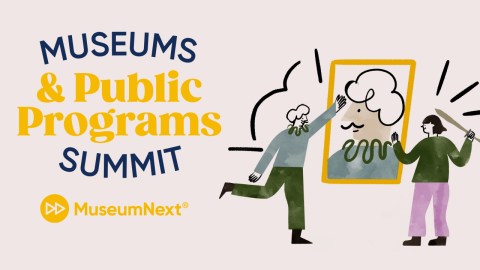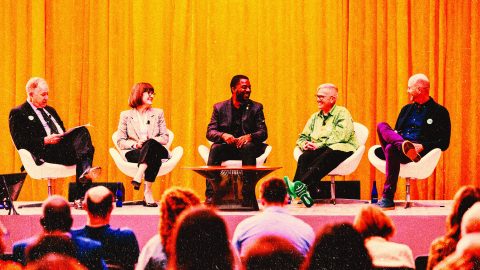For three weeks every November leaders and practitioners from the field of the public history meet at the Seminar for Historical Administration to discuss challenges and future directions for history organizations. This week’s blog post is by John Durel, who coordinates the seminar, and his partner, Anita Durel. John and Anita work with museum executives nationwide and have written frequently about museums and cultural organizations.
The public history field—history museums, historical societies, historic sites and archives—has reached a tipping point. Driven by the need to develop financially sustainable operating models, the impact of technology how individuals access and share information and most importantly the emergence and favorable reception of new leaders with entrepreneurial acumen, the field is no longer hesitant or resistant to change. Though some organizations are lagging, we see a blossoming of ideas and new approaches that promise to make history relevant, meaningful and useful in today’s world.
This is a time of innovation. Here are ten developments we see coming in the years ahead.
1. A National Purpose
Leaders in the field begin to articulate a purpose for history organizations aligning with a nationally recognized need. Children’s museums are building their case around healthy early childhood development as a fundamental right and an investment in the nation’s future. Science centers, in partnership with schools and universities, have established STEM education as essential for our future prosperity. Both children’s and science museums have built a platform to articulate the importance of these respective fields and their link to a strong America. History organizations must do the same. What is the greater good that public history serves? How will improved knowledge and understanding of the past make us better as a nation? In the long run, what difference will history organizations make? The field needs a single, concise statement of purpose that does not require elaborate explanation.
2. An Integrated Programmatic Approach
History organizations will no longer assume that the best methods to present history are thematic exhibitions, historic site tours and living history “experiences.” Programming, generally seen as supplemental to these primary approaches, will begin to play a central role. Staffs, in collaboration with advisors, will brainstorm ways to tell a particular story, explore a topic and engage the public. Science Gallery in Dublin, Ireland, is a good example. Their innovative work includes a series of integrated, edgy and extremely popular programs, incorporating interactive exhibits, online engagement, onsite happenings and public events. We look forward to the history organization that takes this approach and makes the examination of historical phenomena relevant, edgy and fun.
3. The Value of Historical Objects
We expect to see more innovation in the use of three-dimensional collections. The traditional and expensive development of thematic exhibits, laden with numerous objects and interpretive labels, will give way to more flexible and experimental approaches. An early glimpse of this shift is “Controversy” at the Ohio Historical Society. Constrained by time and money, the staff selected objects that prompt a reaction and discussion. Similar constraints will lead to innovation elsewhere. We are already reading about pop up exhibits. Experimenting with the use of objects will help us understand their true value and educational potential.
4. Sharing Historical Authority
The authority for interpreting the past, which resided with professional historians and curators, is increasingly shared with visitors, program participants, online users and community groups. Digitization of collections is making it easy for anyone to use a computer or hand-held device to read documents, view images, and get information about historical topics, locations, events or artifacts. Over the next several years we expect to see more history organizations embrace this change and find ways to involve the public in presenting and interpreting history.
5. Critical Thinking and Historical Practice
As the field learns to share historical authority, it finds ways to help the public develop a more complex and nuanced understanding of history. Building on educational programs developed for youth, such as National History Day, and spurred by IMLS’s 21st Century skills initiative, history organizations offer tools, resources, and “history labs” for both youth and adults. They engage the public not only in an interpretation of the past, but also in understanding how historians arrive at the interpretation. The public (lay historians) receive guidance and support for finding reliable information, thinking critically about primary evidence, considering alternative and multiple perspectives, thinking historically and not projecting today’s assumptions on the past, and crafting narratives that reveal the subtleties and ambiguities of history. (See “What is the role of the historian in the age of shared authority and radical trust?” for further thoughts on this.)
6. The Power of Historical Places
History organizations will engage people “on site, online, or on the road” (to borrow a phrase from the Kentucky Historical Society.) At the same time they will recognize the power of particular places and settings. Following the lead of Historic New England and the historic sites of the National Trust for Historic Preservation, innovative uses of historic properties will continue, enabling people to experience these places even when the purpose is not an overt or explicit history lesson. Historic properties will be both places to gather and places to learn (this time borrowing a phrase from Strawbery Banke Museum in Portsmouth, N.H.)
7. Contentious History
Some history organizations, in some communities, will be compelled to address contentious history. See the Nov. 8 blog post at Developing History Leaders @SHA for our thoughts on this. This requires leaders who are passionate about history, deeply committed to building stronger communities, and have the fortitude to endure attacks. It will also take skilled facilitation. Exploration of the past can easily divide people rather than unite them.
8. Business Thinking
Through our work with museum CEOs in executive roundtables, we are beginning to see increased understanding of business thinking. More leaders are becoming adept at business planning, market research, data driven change, monetizing assets, strategic investment and disinvestment, disciplined measurement of ROI, diversification of revenue, and capitalization. They are also tuning in to changes in philanthropy and the growth of social entrepreneurship, as described in Nonprofit Finance in Hard Times, by Susan U. Raymond.
9. Governing Boards
In spite of our general optimism, we remain deeply concerned about the performance of governing boards. For every conversation we have with an executive director indicating a strong and engaged board, we have five conversations about boards that are inactive, resistant, or worse, undermining change. Without active board engagement in the fund development process, without their willingness to step up to the challenge of raising money, without their enthusiastic financial support for new approaches to the work, it seems unlikely that the current spate of innovation in the field will be sustained. It does not have to be this way—a courageous and committed executive director can give the board the direction and the support it needs to meet its responsibilities for the financial health of the organization.
10. History Leadership
After a delay caused by the recession, we are starting to see the retirement of executive directors who have led organizations since the 1970s and 80s. Opportunities are opening for younger individuals who are department heads or directors of smaller institutions. These younger leaders are responsible for much of the innovation now underway. Their greatest challenge will be to learn how to lead a board. We use the word “lead” here in the sense that Jim Collins uses it in Good to Great and the Social Sector. The leadership challenge is not to make the right decisions, but to make sure that the right decisions get made, and that will require building boards that are fully supportive and actively engaged in the transformation of history organizations.









In general, this blog post is an excellent summary of the challenges in front of the field. To add to the conversation, here are three specific reactions:
As to the National Purpose, looking back at the history of local history provides a sense that perhaps once there had been one. During the Public Archives Commission era (1899-1917) federal funds were used to organize government records on a local level prior to the establishment of the National Archives in 1934. That was useful service to the public, especially veterans of the Civil and Spanish-American wars who were entitled to certain federal benefits. That work was so demonstrably important that Minnesota passed the War Records Commission Act of 1919 (1919-1925) to address the organization and preservation of records related to the Great War. The innovative element of that legislation required there to be a War Records Commission in each county, the antecedent to the county historical societies – and since 1981, there has been a county historical society in each in Minnesota. While today's national purpose need not be focused on veterans, I think it important to look back on the history of local history to see that once there was an important purpose to historical organizations.
As to the power of historical places I happily agree. However, herein lies the greatest challenge going forward. Emerging generations seemingly have the expectation of placelessness – to access whatever they desire whenever and from wherever they may be. History is practically geocoded in its DNA. Solving this disconnect of power of place amid expected placelessness may indeed be the question of the age.
Finally, perhaps one consideration in the likely solution to facilitating change in smaller organizations is to realize that change must start with the executive director. While buy-in from the top (boards) and from grassroots (membership) is key, change has to be driven by the few staff (if any) in between. There is perhaps much that can be learned in this regard from studies of middle management in larger organizations. Studies suggest that having the commitment to change from middle managers can have more influence on the outcome than previously thought.
Here are additional thoughts on some immediate challenges for the field, which I wrote for local historical organizations in Minnesota: http://discussions.mnhs.org/mnlocalhistory/blog/2011/11/28/five-early-21st-century-challenges/